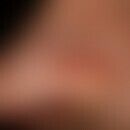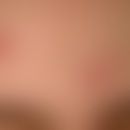DefinitionThis section has been translated automatically.
The FLG gene (FLG stands for filaggrin) is a protein-coding gene located on chromosome 1q21.3. The FLG gene codes for histidine-rich structural proteins of the outermost skin layer, which play an essential role in the formation of keratin as matrix proteins. The encoded proteins(filaggrins) are strongly basic, non- or hardly phosphorylated polypeptides with a molecular weight of 35 kDa, which can be extracted from the stratum corneum and aggregate keratin filaments in vitro. They are formed from profilaggrins.
General informationThis section has been translated automatically.
Filaggrin (FLG) is the main component of the keratohyalin granules of the upper stratum granulosum. It is present as the 400 kDa protein profilaggrin, which is cleaved by proteolytic differentiation into 10-12 filaggrin polypeptides of 37 kDa in a final differentiation step in the stratum granulosum.
In addition to the two most frequent mutations(p.R501X,c2282del4), more than 40 variants are known in the FLG gene. Mutations in the filaggrin gene are associated with atopic dermatitis. Phenotypically, patients with these FLG mutations are characterized by early onset of atopic dermatitis, high serum IgE levels and palmar hyperlinearity.
At the same time, filaggrin mutations significantly increase the risk of asthma (odds ratio = 1.80). The asthma risk is even higher when filaggrin null mutation and atopic dermatitis are combined (OR = 3.16).
The proportion of FLG mutants also appears to be higher in nickel contact sensitized individuals than in other contact sensitized individuals (see nickel allergy below).
There is evidence of a connection between FLG loss-of-function mutations and infectious skin diseases. For example, two FLG loss-of-function mutations (K4022X and Q1790X) are significantly associated with a higher rate of leprosy infections. These results suggest a possible role of filaggrin in the defense against leprosy pathogens (Shi W et al. 2020).
Cyclic citrullinated peptides, which are produced during the degradation of filaggrin (see CCP-AK below), play a diagnostic role in rheumatoid arthritis (up to 80% positive) as well as in psoriasis arthropathica (10-15% positive).
Note(s)This section has been translated automatically.
Two null mutations of the filaggrin gene manifest themselves in the clinical picture of ichthyosis vulgaris. Null mutations of the gene are detected in 5% of Europeans. 50% of these null mutants lead to dry skin, mild ichthyosis and an increased risk of developing atopic eczema.
It is assumed that the cornification and barrier disorder caused by the filaggrin deficiency makes it easier for allergens and microorganisms to penetrate the skin.
A reduced expression of filaggrin can also be caused secondarily by pro-inflammatory TH2 cytokines and other exogenous factors.
LiteratureThis section has been translated automatically.
- Akiyama M (2010) FLG mutations in ichthyosis vulgaris and atopic eczema: spectrum of mutations and population genetics. Br J Dermatol 162:472-477.
- Henderson J et al. (2008) The burden of disease associated with filaggrin mutations: A population-based, longitudinal birth cohort study. J Allergy Clin Immunol121: 872-877
- Hintner H (1985) Filaggrine. Dermatology 36:608-611
- Novak N et al. (2008) Loss-of-function mutations in the filaggrin genes and allergic contact sensitization to nickel. J Invest Dermatol 128: 1430-1435
- Osawa R et al. (2011) Filaggrin gene defects and the risk of developing allergic disorders. Allergol Int 60:1-9.
Shi W et al. (2020) Massively Parallel Sequencing of the Filaggrin Gene Reveals an Association Between FLG Loss-of-function Mutations and Leprosy. Acta Derm Venereol 100:adv00299.
- Thyssen JPet al. (2013) Ichthyosis vulgaris: the filaggrin mutation disease. Br J Dermatol 168:1155-1166.
- Rodrigeuz E et al (2015) Genetics of atopic eczema. Dermatologist 66: 84-89



